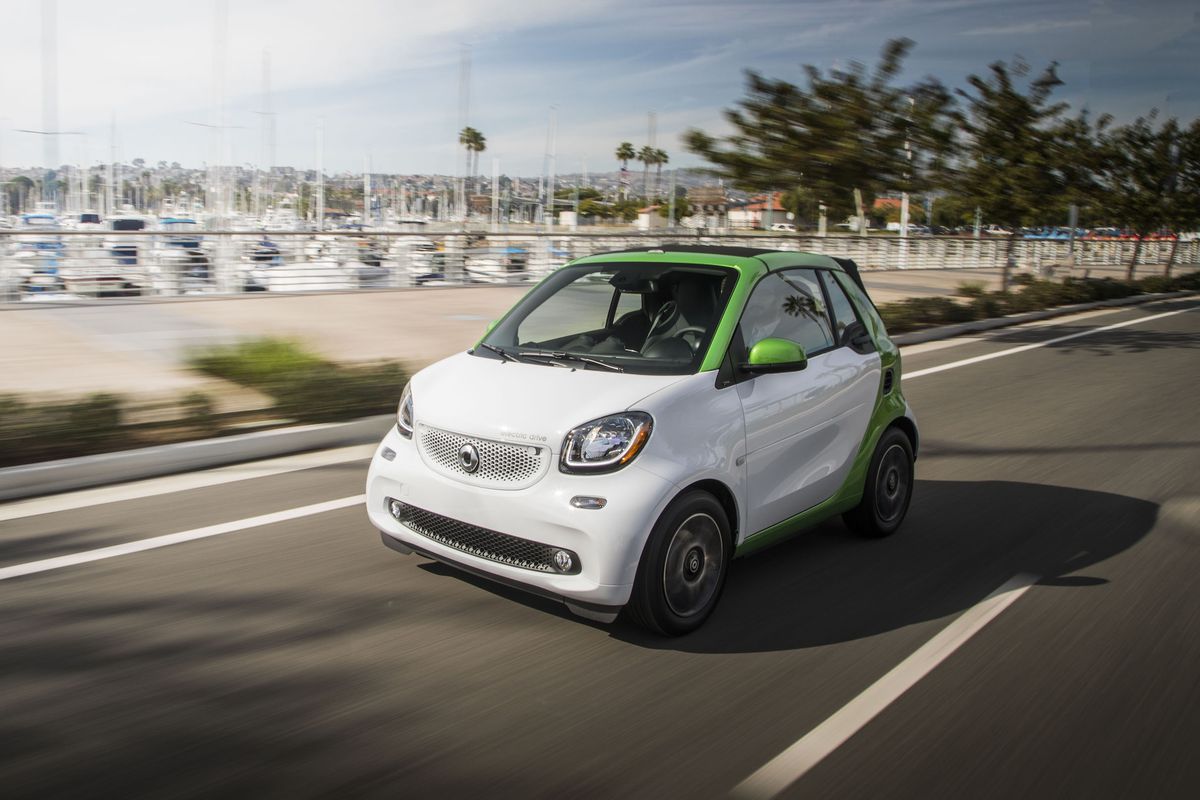/cdn.vox-cdn.com/uploads/chorus_image/image/58726311/_F8A9073_copy.0.jpg)
Look at some of the autonomous vehicle concepts, predicting a future of us being able to treat a car as a lounge or work area when we don’t want to actually drive, and you’ll notice one thing: space. By that, I mean the space they take up on the road. Everyone seems to be designing a large, autonomous SUV because that’s what people want.
Mercedes-Benz is guilty of the same thing, with its vast F105 Concept it showed a few years ago. Sleek, spacious and lounge-like, it’s one idea for a self-driving future. But its tiny Smart division has other ideas. Last month, transportation reporter Sean O’Kane got a “ride” in Smart Vision EQ Fortwo concept — Daimler’s idea of what a self-driving urban car should be. At CES in January, Smart CEO Dr. Annette Winkler told us that the Smart is on its own in the world.
“No other car packs in so much into so small of a space,” she said, which has been a hallmark of the brand. “The beginning of smart was the thinking that cities would need electric cars.”
But back to the present and back to Smart’s present. The brand went all-electric in the US and Canada for 2018 and by 2020, will do the same all over Europe, leaving China as its only major market where the tiny two seater is powered by an internal combustion engine. Despite many electrification claims by other automakers, Smart is on the forefront of abandoning gasoline and diesel engines. Is the world ready for that? Is Smart even ready for that?
/cdn.vox-cdn.com/uploads/chorus_asset/file/10244135/_F8A8022_copy.jpg)
/cdn.vox-cdn.com/uploads/chorus_asset/file/10244137/_F8A8050_copy.jpg)
/cdn.vox-cdn.com/uploads/chorus_asset/file/10244139/_F8A8038_copy.jpg)
As a testament to its design, the Smart is a great urban car. It may only seat two people and has a tiny trunk, but how often do single people or couples without kids need more than two seats to get to a different borough, for example? Or go to the store if they aren’t already getting their groceries delivered? That’s at least been the brand’s logic in the 20 years it’s been selling cars (10 of those in the US). Most people are driving vastly more car than they need, and that’s likely never been more apparent than now with the wave of trucks and SUVs that have been displacing traditional sedans and hatchbacks on the new car sales charts.
So the Smart Fortwo lingers on as a relatively tiny (not even 9-feet long), rather tall and odd-looking two-seater. Its main purpose is function, and that’s apparent with the coupe version. Despite seating for just two and an electric motor mounted under your cargo, there’s sufficient room for two adults and a couple of soft bags, or a suitcase if you’re picking someone up on an airport run. I once found a way to stack 500 copies of my high school newspaper in a Smart, for the record. Will that be enough in 2030 if you hail a Smart in their version of the future?
“I don’t think that people won’t want to own a Smart (in the future),” Dr. Winkler said. “I still think 10 years from now, we will have people who still want to own a car and want to drive a car. But I think that car sharing, in big cities, will become so important.”
/cdn.vox-cdn.com/uploads/chorus_asset/file/10244155/_F8A9217_copy.jpg)
/cdn.vox-cdn.com/uploads/chorus_asset/file/10244157/_F8A8855_copy.jpg)
The convertible version, however, adds another dose of fun to the looks. Push a button and a little canvas roof retracts. Push it again, and the rear window folds down and the canvas top stacks on top of it. Then you pull out each of the rails on either side of the car to get the “full” convertible experience. By which, I mean you get the feeling of conspicuousness when stuck in traffic. Some people think it’s cute, some think it’s incredibly dorky. Pick one with the green accents (as I did when Mercedes-Benz invited some journalists late last year to run around San Diego in these little electric things) and it catches people’s eyes — for better or worse. Those who like to hunker down in their car and lock the world out may not be so enthralled that some people rush up to you and tell you how adorable your car is. But then, a Smart convertible likely wasn’t for you, anyway.
Inside, however, the Smart is surprisingly plush for a tiny car. It may be all plastic-paneled on the outside, but opt for a version with the colorful touchscreen and heated leather seats and the mini-Mercedes vibe starts to seep through. Some of the plastics are economy car-grade (“serviceable,” is a good word), but they’re made up for by silly little details like the battery charge meter that sits on a pod to the left of the driver, or the air vents that sprout off the dash like eyeballs. The seats are, in fact, comfortable, although the high driving position feels especially weird when the roof is open. It starts to feel like an SUV convertible.
/cdn.vox-cdn.com/uploads/chorus_asset/file/10244163/_F8A9381_copy.jpg)
/cdn.vox-cdn.com/uploads/chorus_asset/file/10244165/_F8A9387_copy.jpg)
/cdn.vox-cdn.com/uploads/chorus_asset/file/10244167/_F8A9390_copy.jpg)
Those quirks are erased when you’re trying to get through traffic. The third-generation Smart Electric Drive uses a 60kWh electric motor with a 17.6kW battery pack and has less than 2,400 pounds to move around. Therefore, bursts through traffic gaps are no problem at city speeds. Couple that with the tightest turning radius of any car on sale and the Smart’s maneuverability shines. That’s exactly what this car’s about, but it doesn’t exactly embarrass itself on the highway, either. Merging onto a busy San Diego freeway sounded like a death wish at first, but the electric motor propelled a Smart with two adults easily to 65 mph, and even up to 70 or so to pass some slow-moving Toyota Yarises.
The kicker in all of this, however, is a range of just 58 miles, according to the EPA. Obviously, the space under the cargo floor was really designed to hold a three-cylinder internal combustion engine barely larger than what powers some motorcycles, so the motor and battery pack can only be so large. Lower battery costs and improved density will be Smart’s friend in the future, Mercedes officials said after the drive. But in the current Electric Drive’s defense, an afternoon of energetic driving of about 20-something miles through the greater San Diego area — and that freeway run — left more than half the charge. Smart counters the low range compared to the likes of the Hyundai Ioniq EV (110 miles) and the Chevy Bolt (238 miles) with the fact its 7.2kWh onboard charger can allow Level 2 charging from empty to full in about three hours. Charging on a household outlet will still take more than half a day, however, but two to three hours is a logical time to spend at a Level 2 public charging station, the company thinks. This Smart still doesn’t support DC fast charging, though.
Then there’s the issue of availability. While the Smart is technically a 50-state car, you can’t actually find a dealer that sells them in all 50 states. In the move to an electric-only line, the vast majority of the Mercedes-Benz dealers that once also shifted Smarts elected to become service-only. With just 28 places to take delivery of a Smart in the US (there are another 58 service points), and most of those are around major metropolitan areas, the narrow scope of the car in this country seems clearer than ever.
/cdn.vox-cdn.com/uploads/chorus_asset/file/10244169/_F8A9522_copy.jpg)
/cdn.vox-cdn.com/uploads/chorus_asset/file/10244343/_F8A9502_copy.jpg)
/cdn.vox-cdn.com/uploads/chorus_asset/file/10244345/_F8A8092_copy.jpg)
The Smart coupe starts off reasonably enough, at $24,650 before federal and regional tax incentives. In California, for example, the Smart Fortwo Electric Drive Pure Coupe becomes a sub-$15,000 EV. It’s also being advertised with a $129 per month lease for 36 months at time of writing, which starts to justify itself as a second car or city commuter if your other car is something large and inefficient. But opting for the Cabrio, and making the most of the Smart’s special selling point, starts to get out of control, starting from $28,850 before incentives. The highly equipped Prime Cabrio we tested — with things like leather seats, built-in navigation that doesn’t include CarPlay or Android Auto, an upgraded audio system, and even a heated steering wheel — priced out at $32,180.
That buys a pretty well-equipped 2018 Nissan Leaf, another 50-state EV that, while no Tesla Model 3, benefits from nearly 100 more miles of range than the Smart, a vastly superior dealer network, and the fact that it has five seatbelts and a roomy trunk. Yes, it’s significantly down on the cute factor and leases for considerably more than a base Smart right now, but if it’s a second car for the suburbs, the Leaf will appeal to more commuters and families.
Somewhere in the future, however, with improved public charging resources and battery density and costs, the Smart Fortwo Electric Drive could have a prosperous future. Much farther out, the Smart could even have an autonomous future when the amount of road space shrinks even more and vehicle size plays a more significant role in purchases and what consumers deem as practical. Today, however, an electric Smart is a coastal oddity likely relegated to owners with parking problems or those seeking an inexpensive way to get into the High Occupancy Vehicle lane.
[“Source-theverge”]





